Before I started designing layouts for others, I thought the process of layout design was inevitably fraught with roadblocks. But in the last few years, I've noticed that designing layouts for others is sometimes challenging, but there's always a way forward. I'm much more likely to be stymied working on my own design, however.
I think this is because there is always a process of concession and compromise in layout design. When working with someone else's "givens and 'druthers", it's relatively easy to prioritize between conflicting elements. But deciding which of my own precious desires to toss overboard is still challenging. And sometimes I make a decision on my own design that nags at me.
One of these was my plan for ATSF's Alice Street Yard*. This "pocket" prototype served a clutch of customers along Oakland's Inner Harbor with tracks that were otherwise unconnected to the Santa Fe except via a car float from Richmond. The Alice Street trackage, quite compact in real life, was spread out over an area about half-again the scale size of the real thing in twisting and turning things around in the garage. Holy selective expansion, Batman!
And it has bugged me.
So it's back to the drawing board for Alice Street. I'm not sure exactly where it's going to end up, maybe as a "Sklylobe"† over the car, but I feel more comfortable now that I will be exploring the essential cramped nature of the prototype.
Thanks for visiting, see my latest posts here
*Alice Street was covered extensively in W. W. Childers' article in the Third Quarter 2001 issue of The Warbonnet, the Santa Fe Railway Historical and Modeling Society's excellent magazine.
†I wrote about the Skylobe concept in the LD SIG's Layout Design Journal, issues #28 and #35.
Sunday, June 24, 2007
Wednesday, June 20, 2007
The (slightly) intentional railfan
A few months ago I wrote about my "accidental railfan" trip along the joint UP/BNSF Tehachapi crossing. As you may recall, I was not well prepared: no camera; less-than-interested car mates; etc.
Well, I had the chance to travel through the area again and especially since I am working on a design that features the area, I thought I would be a little more serious this time. OK, but not too serious. It seems the family needed the digital while I was gone, so I bravely set out with an old film snapshot camera. First stop on the way down to So Cal: Caliente, a key element on the layout project.
After getting my bearings, a quick look around and I spy a decent spot to get a bird's-eye view. Climb up the hill and I hear flanges squealing. Real railfans go out all day and never see a thing; I bumble onto a train in the first five minutes. Oh yeah, and the camera's down in the car. Nuts! It was great though, you shoulda seen it.
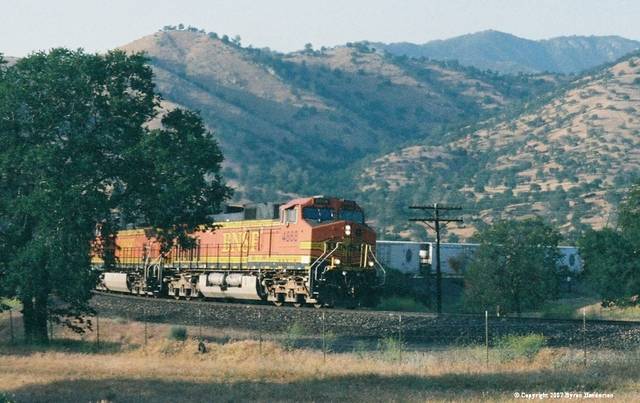 Anyway, I realize this mixed BNSF manifest is on its way toward the Loop … and as it happens, so am I! Back in the car, return to the Freeway and jump off again at Keene, wind along down to Tunnel 9 on the famous Loop. This time I take the camera with me. The sun is on its way down, so there won't be a long wait one way or the other -- either a train will arrive or it will be dark. But soon enough I hear airhorns in the distance.
Anyway, I realize this mixed BNSF manifest is on its way toward the Loop … and as it happens, so am I! Back in the car, return to the Freeway and jump off again at Keene, wind along down to Tunnel 9 on the famous Loop. This time I take the camera with me. The sun is on its way down, so there won't be a long wait one way or the other -- either a train will arrive or it will be dark. But soon enough I hear airhorns in the distance.
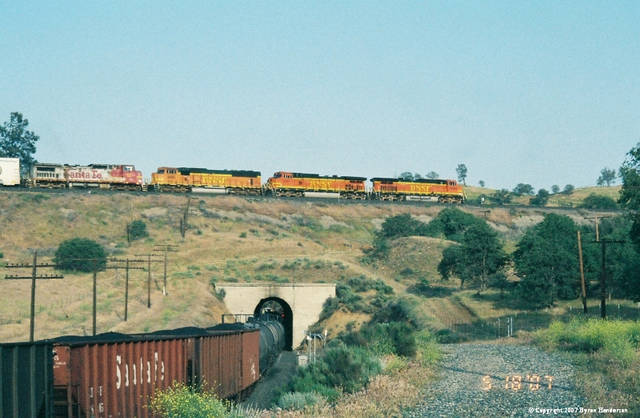 In the late afternoon light the same train I saw in Caliente is curving around the entrance to Tunnel #9 and the Loop. Quick photo or two and a friendly (I hope) horn blast from the engineer startles me as BNSF Techno-Toaster 4868 wheels its train of reefers, tankcars and coal or coke hoppers around the Loop. Oh, yeah, and I took the requisite crossover shot. OK, I'm still not sure I'm cut out to be a modern day railfan, but that was pretty neat.
In the late afternoon light the same train I saw in Caliente is curving around the entrance to Tunnel #9 and the Loop. Quick photo or two and a friendly (I hope) horn blast from the engineer startles me as BNSF Techno-Toaster 4868 wheels its train of reefers, tankcars and coal or coke hoppers around the Loop. Oh, yeah, and I took the requisite crossover shot. OK, I'm still not sure I'm cut out to be a modern day railfan, but that was pretty neat.
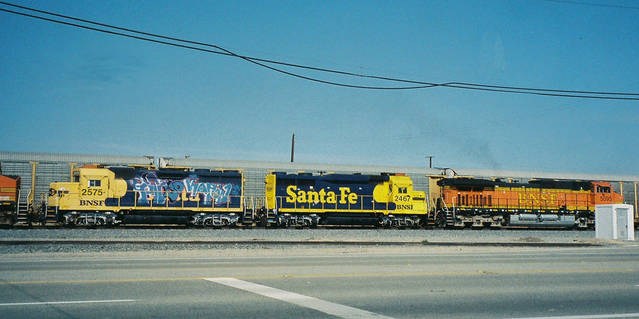 On the return leg to the bay area, I decide to be a little more organized about this. With a photo or two at the Loop already in the camera, I want to focus on some other areas. Couple of quick photos in Mojave to capture some neat things that might not be there for long (like the sign at White's Motel) and I see a BNSF train headed out of town toward Tehachapi. It's not often that I have seen a loco defaced with graffiti, but this GP-35 has received a vandal's unwanted attention.
On the return leg to the bay area, I decide to be a little more organized about this. With a photo or two at the Loop already in the camera, I want to focus on some other areas. Couple of quick photos in Mojave to capture some neat things that might not be there for long (like the sign at White's Motel) and I see a BNSF train headed out of town toward Tehachapi. It's not often that I have seen a loco defaced with graffiti, but this GP-35 has received a vandal's unwanted attention.
On up over Tehachapi on a beautiful spring Sunday (mid-May). Returning to Caliente, I drive around for a few establishing shots that I need for the track plan. I was surprised to see a few cars parked at the (closed on Sunday) Post Office and a couple of guys standing around talking. Locals, I guess -- maybe this passes for an outing in Caliente on a Sunday afternoon.
Then I head just outside of town to my vantage point from a few days before. OK, this is a pleasant afternoon eating a sandwich the Moms packed in the shade of an old oak, but this railfanning outing seems to be more like a solitary picnic sans train. (Yes, I'm a wimp -- I did say I was only a slightly intentional railfan.)
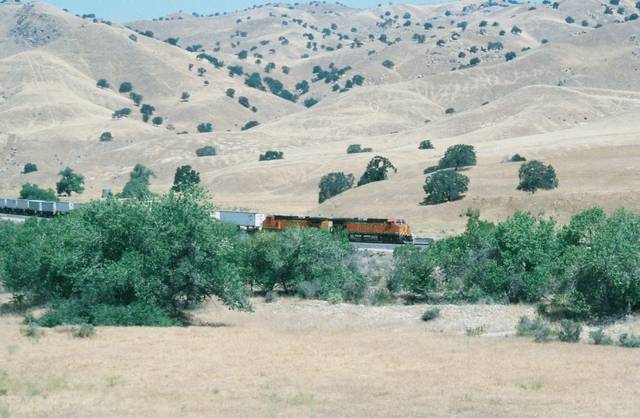 But then, airhorns. A BNSF TOFC (Trailer on Flatcar) train is working its way into Caliente. I catch it across the valley as it pulls in from the site of the former Tunnel #1/2. Soon the full train is laid out around the curve as BNSF 4597 rolls by my sidehill perch.
But then, airhorns. A BNSF TOFC (Trailer on Flatcar) train is working its way into Caliente. I catch it across the valley as it pulls in from the site of the former Tunnel #1/2. Soon the full train is laid out around the curve as BNSF 4597 rolls by my sidehill perch.
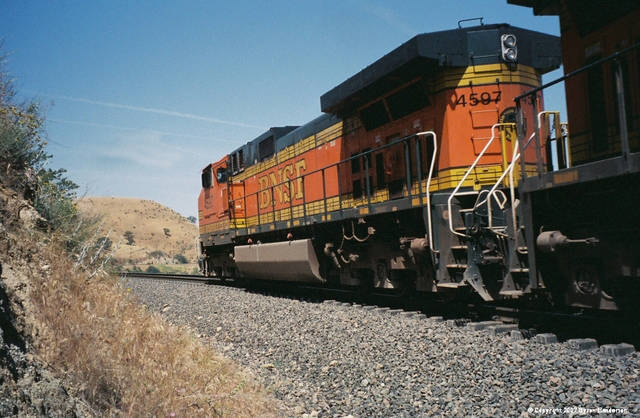 Just after the train pulls out of town, I start to do the same. Roaring past me at the intersection are the three cars that were parked at the Post Office. Railfans! (The intentional variety, no doubt.) From the layout design project, I know the BSNF train is headed to Bealeville, which I'll cross on the road out of Caliente.
Just after the train pulls out of town, I start to do the same. Roaring past me at the intersection are the three cars that were parked at the Post Office. Railfans! (The intentional variety, no doubt.) From the layout design project, I know the BSNF train is headed to Bealeville, which I'll cross on the road out of Caliente.
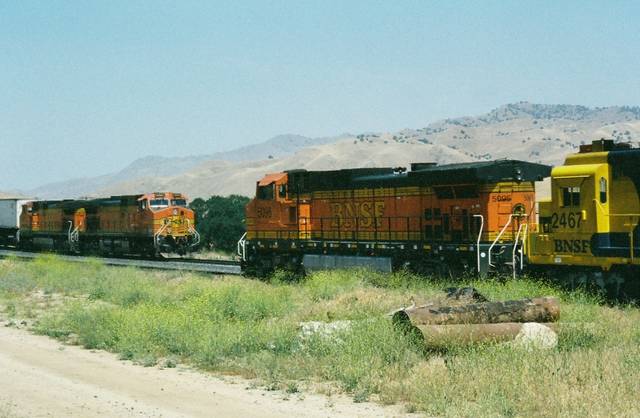 The more serious railfans are long out of sight as I wind up the hill to Bealeville. When I arrive, they are nowhere to be found, until I look up on the nearby hills where they have perched, tripods at the ready. Within minutes, the TOFC train we saw in Caliente has arrived, stopped, and dimmed its headlight. And in the other direction comes the same mixed consist I had seen earlier departing Mojave. This quick photo of the resulting Bealeville meet was the last on that roll of film, so my railfan excursion had come to an end. (My more serious railfanning comrades raced off to parts unknown to bag their next ream of images.)
The more serious railfans are long out of sight as I wind up the hill to Bealeville. When I arrive, they are nowhere to be found, until I look up on the nearby hills where they have perched, tripods at the ready. Within minutes, the TOFC train we saw in Caliente has arrived, stopped, and dimmed its headlight. And in the other direction comes the same mixed consist I had seen earlier departing Mojave. This quick photo of the resulting Bealeville meet was the last on that roll of film, so my railfan excursion had come to an end. (My more serious railfanning comrades raced off to parts unknown to bag their next ream of images.)
All in all, a lot of luck, some very pleasant time spent in pretty country, useful research for my client's project, and a few photos to remember it all by. Not bad for a somewhat-less-accidental railfan …
Thanks for visiting, click here to see the latest posts
 Currently listening to Appalachia Waltz by Yo-Yo Ma, Edgar Meyer, and Mark O'Conner. This instrumental music has a timeless, evocative, instantly nostalgic feel that really needs no description except to say that it is truly beautiful.
Currently listening to Appalachia Waltz by Yo-Yo Ma, Edgar Meyer, and Mark O'Conner. This instrumental music has a timeless, evocative, instantly nostalgic feel that really needs no description except to say that it is truly beautiful.
Well, I had the chance to travel through the area again and especially since I am working on a design that features the area, I thought I would be a little more serious this time. OK, but not too serious. It seems the family needed the digital while I was gone, so I bravely set out with an old film snapshot camera. First stop on the way down to So Cal: Caliente, a key element on the layout project.
After getting my bearings, a quick look around and I spy a decent spot to get a bird's-eye view. Climb up the hill and I hear flanges squealing. Real railfans go out all day and never see a thing; I bumble onto a train in the first five minutes. Oh yeah, and the camera's down in the car. Nuts! It was great though, you shoulda seen it.
 Anyway, I realize this mixed BNSF manifest is on its way toward the Loop … and as it happens, so am I! Back in the car, return to the Freeway and jump off again at Keene, wind along down to Tunnel 9 on the famous Loop. This time I take the camera with me. The sun is on its way down, so there won't be a long wait one way or the other -- either a train will arrive or it will be dark. But soon enough I hear airhorns in the distance.
Anyway, I realize this mixed BNSF manifest is on its way toward the Loop … and as it happens, so am I! Back in the car, return to the Freeway and jump off again at Keene, wind along down to Tunnel 9 on the famous Loop. This time I take the camera with me. The sun is on its way down, so there won't be a long wait one way or the other -- either a train will arrive or it will be dark. But soon enough I hear airhorns in the distance. In the late afternoon light the same train I saw in Caliente is curving around the entrance to Tunnel #9 and the Loop. Quick photo or two and a friendly (I hope) horn blast from the engineer startles me as BNSF Techno-Toaster 4868 wheels its train of reefers, tankcars and coal or coke hoppers around the Loop. Oh, yeah, and I took the requisite crossover shot. OK, I'm still not sure I'm cut out to be a modern day railfan, but that was pretty neat.
In the late afternoon light the same train I saw in Caliente is curving around the entrance to Tunnel #9 and the Loop. Quick photo or two and a friendly (I hope) horn blast from the engineer startles me as BNSF Techno-Toaster 4868 wheels its train of reefers, tankcars and coal or coke hoppers around the Loop. Oh, yeah, and I took the requisite crossover shot. OK, I'm still not sure I'm cut out to be a modern day railfan, but that was pretty neat. On the return leg to the bay area, I decide to be a little more organized about this. With a photo or two at the Loop already in the camera, I want to focus on some other areas. Couple of quick photos in Mojave to capture some neat things that might not be there for long (like the sign at White's Motel) and I see a BNSF train headed out of town toward Tehachapi. It's not often that I have seen a loco defaced with graffiti, but this GP-35 has received a vandal's unwanted attention.
On the return leg to the bay area, I decide to be a little more organized about this. With a photo or two at the Loop already in the camera, I want to focus on some other areas. Couple of quick photos in Mojave to capture some neat things that might not be there for long (like the sign at White's Motel) and I see a BNSF train headed out of town toward Tehachapi. It's not often that I have seen a loco defaced with graffiti, but this GP-35 has received a vandal's unwanted attention.On up over Tehachapi on a beautiful spring Sunday (mid-May). Returning to Caliente, I drive around for a few establishing shots that I need for the track plan. I was surprised to see a few cars parked at the (closed on Sunday) Post Office and a couple of guys standing around talking. Locals, I guess -- maybe this passes for an outing in Caliente on a Sunday afternoon.
Then I head just outside of town to my vantage point from a few days before. OK, this is a pleasant afternoon eating a sandwich the Moms packed in the shade of an old oak, but this railfanning outing seems to be more like a solitary picnic sans train. (Yes, I'm a wimp -- I did say I was only a slightly intentional railfan.)
 But then, airhorns. A BNSF TOFC (Trailer on Flatcar) train is working its way into Caliente. I catch it across the valley as it pulls in from the site of the former Tunnel #1/2. Soon the full train is laid out around the curve as BNSF 4597 rolls by my sidehill perch.
But then, airhorns. A BNSF TOFC (Trailer on Flatcar) train is working its way into Caliente. I catch it across the valley as it pulls in from the site of the former Tunnel #1/2. Soon the full train is laid out around the curve as BNSF 4597 rolls by my sidehill perch. Just after the train pulls out of town, I start to do the same. Roaring past me at the intersection are the three cars that were parked at the Post Office. Railfans! (The intentional variety, no doubt.) From the layout design project, I know the BSNF train is headed to Bealeville, which I'll cross on the road out of Caliente.
Just after the train pulls out of town, I start to do the same. Roaring past me at the intersection are the three cars that were parked at the Post Office. Railfans! (The intentional variety, no doubt.) From the layout design project, I know the BSNF train is headed to Bealeville, which I'll cross on the road out of Caliente. The more serious railfans are long out of sight as I wind up the hill to Bealeville. When I arrive, they are nowhere to be found, until I look up on the nearby hills where they have perched, tripods at the ready. Within minutes, the TOFC train we saw in Caliente has arrived, stopped, and dimmed its headlight. And in the other direction comes the same mixed consist I had seen earlier departing Mojave. This quick photo of the resulting Bealeville meet was the last on that roll of film, so my railfan excursion had come to an end. (My more serious railfanning comrades raced off to parts unknown to bag their next ream of images.)
The more serious railfans are long out of sight as I wind up the hill to Bealeville. When I arrive, they are nowhere to be found, until I look up on the nearby hills where they have perched, tripods at the ready. Within minutes, the TOFC train we saw in Caliente has arrived, stopped, and dimmed its headlight. And in the other direction comes the same mixed consist I had seen earlier departing Mojave. This quick photo of the resulting Bealeville meet was the last on that roll of film, so my railfan excursion had come to an end. (My more serious railfanning comrades raced off to parts unknown to bag their next ream of images.)All in all, a lot of luck, some very pleasant time spent in pretty country, useful research for my client's project, and a few photos to remember it all by. Not bad for a somewhat-less-accidental railfan …
Thanks for visiting, click here to see the latest posts
 Currently listening to Appalachia Waltz by Yo-Yo Ma, Edgar Meyer, and Mark O'Conner. This instrumental music has a timeless, evocative, instantly nostalgic feel that really needs no description except to say that it is truly beautiful.
Currently listening to Appalachia Waltz by Yo-Yo Ma, Edgar Meyer, and Mark O'Conner. This instrumental music has a timeless, evocative, instantly nostalgic feel that really needs no description except to say that it is truly beautiful.
Saturday, June 16, 2007
Model motivation
Sometimes a particular model will give me a little boost and motivate me to work on the layout. One of these is a cool little SW-1 model built for me by "Crittermeister" Randy Gustafson, whose neat compact Hickory Valley RR was featured in the July 1995 Model Railroader. Randy has built all manner of small locos in N scale, fearlessly scrathbuilding and kitbashing shells and mechanisms.
 This SW-1 is made from a shell casting pulled from Randy's custom mold and a modified Kato NW-2 drive. Custom brass handrails complete the switcher, which wears a "darned close" livery made up of decals pieced together from a couple of commercial sets. (All photos by Randy).
This SW-1 is made from a shell casting pulled from Randy's custom mold and a modified Kato NW-2 drive. Custom brass handrails complete the switcher, which wears a "darned close" livery made up of decals pieced together from a couple of commercial sets. (All photos by Randy).
This little gem will be borrowed/leased power for the Howard Terminal segment of the layout, a separate section built as a flip-up portable island. The Howard Terminal will provide DC on the rails, so there's no decoder in the SW-1 -- we used the space for more weight. Looks great, runs great, makes me want to get more done on the layout. So why am I blogging … hmmm.
 Randy posts quite often in the Atlas N scale forum, so I decided to drop in and comment on the thread where he described the process of creating the SW-1. Since I was in a forum anyway, I decided to look around the web and see if things have changed on the forum scene during my self-imposed exile.
Randy posts quite often in the Atlas N scale forum, so I decided to drop in and comment on the thread where he described the process of creating the SW-1. Since I was in a forum anyway, I decided to look around the web and see if things have changed on the forum scene during my self-imposed exile.
Yeesh … that was a mistake. Not much has changed, least of all my tolerance for jerks and blowhards. Guess I'm not quite ready to venture back onto the forums.
Forum foolishness aside, the Internet is an amazing medium for connecting us to small companies and individuals (like Randy) that can provide modeling possibilities beyond our own personal skills. Even though it's only running on my interim switching layout now, Randy's SW-1 is a unique model that's giving me a good shot of inspiration.
 This SW-1 is made from a shell casting pulled from Randy's custom mold and a modified Kato NW-2 drive. Custom brass handrails complete the switcher, which wears a "darned close" livery made up of decals pieced together from a couple of commercial sets. (All photos by Randy).
This SW-1 is made from a shell casting pulled from Randy's custom mold and a modified Kato NW-2 drive. Custom brass handrails complete the switcher, which wears a "darned close" livery made up of decals pieced together from a couple of commercial sets. (All photos by Randy).This little gem will be borrowed/leased power for the Howard Terminal segment of the layout, a separate section built as a flip-up portable island. The Howard Terminal will provide DC on the rails, so there's no decoder in the SW-1 -- we used the space for more weight. Looks great, runs great, makes me want to get more done on the layout. So why am I blogging … hmmm.
 Randy posts quite often in the Atlas N scale forum, so I decided to drop in and comment on the thread where he described the process of creating the SW-1. Since I was in a forum anyway, I decided to look around the web and see if things have changed on the forum scene during my self-imposed exile.
Randy posts quite often in the Atlas N scale forum, so I decided to drop in and comment on the thread where he described the process of creating the SW-1. Since I was in a forum anyway, I decided to look around the web and see if things have changed on the forum scene during my self-imposed exile.Yeesh … that was a mistake. Not much has changed, least of all my tolerance for jerks and blowhards. Guess I'm not quite ready to venture back onto the forums.
Forum foolishness aside, the Internet is an amazing medium for connecting us to small companies and individuals (like Randy) that can provide modeling possibilities beyond our own personal skills. Even though it's only running on my interim switching layout now, Randy's SW-1 is a unique model that's giving me a good shot of inspiration.
Monday, June 11, 2007
Big Little News, Little Big News
There are certainly more products available than ever in model railroading. This is true in all scales (OK, except maybe TT), but I pay the most attention to N scale announcements. I found it interesting that two recent announcements were at more-or-less opposite ends of the scale. Kato's NW-2 and Athearn's Challenger.
Beginning with the latter, what is it with Challengers and Big Boys? What are there, four Big Boys in production in HO now? Athearn's N scale Challenger has been reasonably well-reviewed and comes with on-board sound. Of course, most N scale layouts lack the 16" or larger radii required for this monster to really look good ... and it's out of place on all but a few layouts set in relatively narrow eras (UP, D&RGW, Clinchfield). Obviously, a big engine is interesting as a novelty, to a collector, or to someone who operates an eclectic motive power fleet.
 Currently listening to The Derek Trucks Band's Joyful Noise. What a pedigree this guy has. Joined the Allman Brothers in his 20s, recently toured with Eric Clapton, married to blues artist Susan Tedeschi. This album is jazz, rock, blues, fusion, afro/cuban ... a little of everything with a southern rock thing bubbling to the top every so often. Great listening for something different.
Currently listening to The Derek Trucks Band's Joyful Noise. What a pedigree this guy has. Joined the Allman Brothers in his 20s, recently toured with Eric Clapton, married to blues artist Susan Tedeschi. This album is jazz, rock, blues, fusion, afro/cuban ... a little of everything with a southern rock thing bubbling to the top every so often. Great listening for something different.
Beginning with the latter, what is it with Challengers and Big Boys? What are there, four Big Boys in production in HO now? Athearn's N scale Challenger has been reasonably well-reviewed and comes with on-board sound. Of course, most N scale layouts lack the 16" or larger radii required for this monster to really look good ... and it's out of place on all but a few layouts set in relatively narrow eras (UP, D&RGW, Clinchfield). Obviously, a big engine is interesting as a novelty, to a collector, or to someone who operates an eclectic motive power fleet.
On the other hand, the prototype for Kato's NW-2 sold over 1,100 copies, probably ten times the number of units and at least that many more prototype RRs than the Challenger. These operated for decades, sometimes as used units with a wide variety of later owners. The NW-2 could be found on terminal operations and on Class 1s. The model is only available in three or four liveries so far, but more will likely be added. The little switcher runs great, truly amazing for its size, and operates on 9 3/4" radius curves, making it suitable for the vast majority of N scale layouts.
So which do you think got more play in the model press? And which do you think I believe is more useful to most of us? The answers are in the title of this blog entry.
 Currently listening to The Derek Trucks Band's Joyful Noise. What a pedigree this guy has. Joined the Allman Brothers in his 20s, recently toured with Eric Clapton, married to blues artist Susan Tedeschi. This album is jazz, rock, blues, fusion, afro/cuban ... a little of everything with a southern rock thing bubbling to the top every so often. Great listening for something different.
Currently listening to The Derek Trucks Band's Joyful Noise. What a pedigree this guy has. Joined the Allman Brothers in his 20s, recently toured with Eric Clapton, married to blues artist Susan Tedeschi. This album is jazz, rock, blues, fusion, afro/cuban ... a little of everything with a southern rock thing bubbling to the top every so often. Great listening for something different.
Subscribe to:
Posts (Atom)